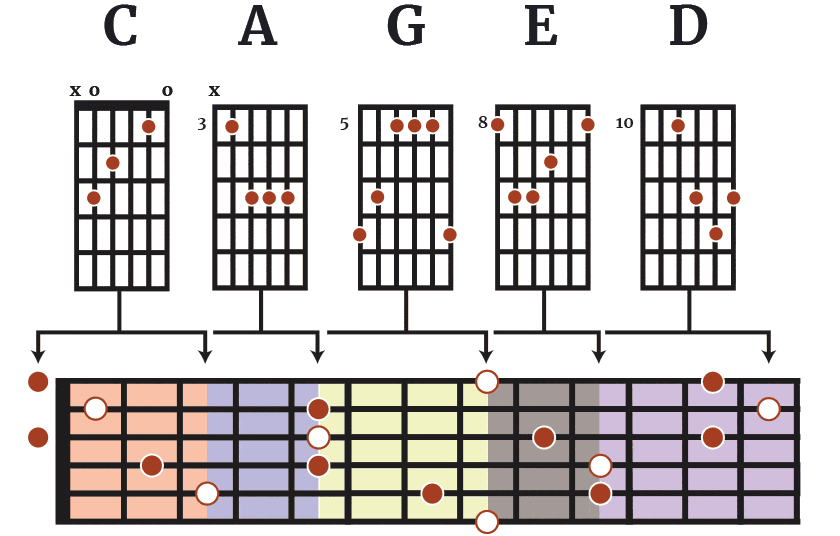Understanding the CAGED System on Guitar
Learning the guitar can sometimes feel like a maze. Chords, scales, and patterns can all seem disconnected, especially when you’re trying to navigate the fretboard. But there’s a method that ties everything together: the CAGED System.
The CAGED System is a straightforward way to understand how chords, scales, and arpeggios are connected across the guitar neck. It’s ideal for players of all skill levels, helping you make sense of the fretboard and expand your playing. Let’s break it down step by step.
What Is the CAGED System?
At its core, the CAGED System is built around five simple open chord shapes:
• C
• A
• G
• E
• D
These are chords you’ve likely learned early on. The clever part is that these shapes can be moved around the fretboard to play the same chord in different positions. Together, they form a framework that covers the entire neck of the guitar.
How It Works
Take the open C chord as an example. By moving this shape up the neck (and compensating for the nut with a barre), you can turn it into a new chord. Move it far enough, and you’ll eventually find yourself back at the same chord you started with—just higher up the neck.
The same principle applies to the A, G, E, and D shapes. These five patterns overlap, creating a complete map of the fretboard.
Why Use the CAGED System?
1. Fretboard Awareness
Many guitarists struggle with connecting different parts of the neck. The CAGED System bridges that gap, making the fretboard easier to understand.
2. Chord Versatility
Using the system, you can play the same chord in multiple positions, giving you more variety in how you voice your chords.
3. Better Soloing
The shapes aren’t just for chords—they’re also linked to scales and arpeggios, making it easier to play melodies and solos across the neck.
Breaking Down Each Shape
Here’s how each shape works:
• C Shape: Start with an open C chord. As you move this shape up the fretboard, it transforms into a new chord, but the pattern stays the same. For example, at the 5th fret, it becomes an F chord.
• A Shape: This open chord forms a barre chord as you slide it up. It’s one of the most commonly used shapes.
• G Shape: Although trickier to shift, the G shape is useful for covering certain parts of the fretboard.
• E Shape: The E shape is often the first barre chord guitarists learn, and it works beautifully all over the neck.
• D Shape: Small but mighty, the D shape provides higher-pitched chord voicings that are great for adding variety.
Tips for Using the CAGED System
1. Start Small
Focus on one shape at a time and practise moving it up the fretboard. Pay attention to the chords it creates in each position.
2. Connect the Shapes
Over time, you’ll notice how the shapes link together. For example, the C shape flows into the A shape, and so on.
3. Practise with Scales
Each shape corresponds to a major scale pattern. Learning these scales will help you solo more confidently and explore new melodic ideas.
Putting It Into Practice
To really get the hang of the CAGED System, apply it to songs you already know. Take a simple chord progression and play it in different positions using the CAGED shapes. For example, try playing G–C–D in multiple places on the neck.
You can also use the system for improvisation. If you’re playing over a chord progression, the shapes will help you find the right notes for your solos.
In Summary
The CAGED System is a simple yet powerful way to unlock the full potential of the guitar. By learning how the five chord shapes connect, you’ll gain a deeper understanding of the fretboard and open up new possibilities for chords, scales, and solos.
Take your time with it, practise regularly, and most importantly, enjoy the process. With a bit of patience, the CAGED System can transform how you play the guitar.
FAQs About Guitar Lessons with Ben Makes Music
What is Ben Makes Music?
Ben Makes Music provides guitar lessons for all levels across Essex, including Rayleigh, Hockley, Hullbridge, and surrounding areas.
What types of guitar lessons are available?
Lessons cover a range of styles, including rock, blues, classical, and more. Whether you’re a beginner or advanced player, there’s a lesson for you!
How do I book a lesson?
Booking a lesson is simple! Contact us online or by phone to arrange your guitar lessons in Essex, including Rayleigh, Hockley, Hullbridge, and beyond.
Are online lessons available?
Yes! High-quality online guitar lessons are available for students in Essex and beyond.
Are the lessons suitable for beginners?
Absolutely! Whether you're in Hockley, Leigh-on-Sea, or elsewhere, step-by-step guidance is provided to help you get started on your guitar journey.
Where can I take lessons?
Guitar lessons are available in the following locations across Essex:
Guitar Lessons in Rayleigh
Guitar Lessons in Hockley
Guitar Lessons in Hullbridge
Guitar Lessons in Wickford
Guitar Lessons in South Woodham Ferrers
Guitar Lessons in Leigh-on-Sea
Guitar Lessons in Eastwood
Guitar Lessons in Benfleet
Guitar Lessons in Basildon
Guitar Lessons in Thundersley
Guitar Lessons in Rochford
Why choose Ben Makes Music?
Each lesson is personalised to meet your goals, ensuring fast progress and a fun, engaging learning experience.
Are guitar lessons worth it?
Definitely! Personalised feedback helps you progress faster than relying on free resources.
Can I try a lesson first?
Yes! Book a trial lesson to see if the approach works for you before committing.
Let’s get started on your guitar journey!


